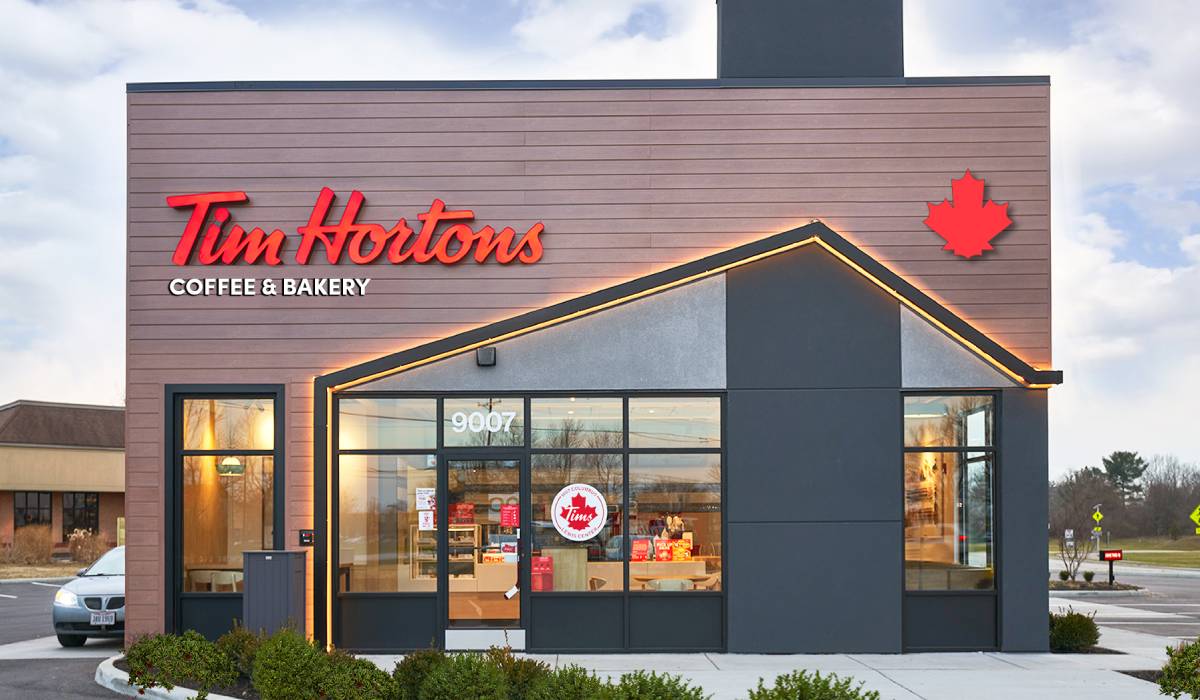Tim Hortons is more involved in Canadian culture than any other brand in another country across the world.
For perspective, there are 38 million residents in Canada and nearly 3,900 Tim Hortons restaurants. Meaning, there’s one restaurant for every 10,000 people. In the U.S., there’s one McDonald’s for every 25,000 people.
And business couldn’t be going better up north. In Q4, Tim Hortons Canada saw same-store sales rise 11 percent on top of 11.3 percent growth in the year-ago period. For the full 2022, comps lifted 11.6 percent, lapping a 10.8 percent increase. Digital mixed 33 percent last year, which is important because those guests spend 5x more over one year. Elsewhere around the world, Tims China opened its first coffee store in February 2019. On January 17, the 600th unit officially debuted. The company has a goal of reaching 2,750 restaurants by 2026. The master franchisees’ same-store sales increased 7.5 percent in the fourth quarter, on top of 6.6 percent growth.
READ MORE: Inside the Evolution of Tim Hortons
Ryan Ferranti, who leads business development for Tim Hortons U.S., describes the company’s international expansion as “outstanding.” He estimates it to be 10x over the past three years. Now, the executive wants the same domestically.
“We’re taking a lot of the learnings that we’ve discovered in our international business and bringing it here to the U.S.,” Ferranti says.
A majority of the roughly 630 stores in the U.S. are based in the Northeast and Upper Midwest, which makes sense given the region’s proximity to the Canadian border. For the rest of the country, part of the growth strategy is working with Canadian consulate generals in major cities to understand their Canadian population. These officials have information on Canadian businesses in the area, visas, tourism, and more.
However, Ferranti emphasizes that it’s just a portion of the process. Tim Hortons is Canadian at its core, but the brand wants to appeal to everyone in a certain market. The coffee chain still operates by typical standards like population density, traffic, and community demographics.
Last year, The brand announced a 30-unit deal for Houston and a 15-unit agreement in Atlanta.
“Our products, in terms of feedback from our guests, are that they are really better than our competitors. Our price and value also beats the mark,” Ferranti says. “So we actually think for non-Canadians, we just need to grow in the right way.”
Between January 2020 and 2023, Tim Hortons lost a net of 20 stores in the U.S, according to its FDD. Ferranti attributes slower growth to shops being far apart in newer trade areas. He adds that coffee is a habitual beverage and that it’s difficult to build routines without proper awareness and convenience. In the future, quickly penetrating markets will become a focus. As an example, Tim Hortons opened two units in Houston last year and another three to four restaurants will debut in 2023. Ferranti says some Canadian customers drove as far as 2.5 hours to visit the brand.
Other key pieces include supporting franchisees with local media and building a “more robust” operations team to ensure owners get off to a good start.
“We’re learning from our experiences opening in that [Houston] market and continuing to improve how we want to penetrate new markets with the right franchisees, the right media,” Ferranti says.
The development veteran says Tim Hortons U.S. aspires to replicate what’s in Canada, but he’s also realistic. Ferranti knows there are Dunkin’ and Starbucks U.S. strongholds, and Tim Hortons eventually wants to go there. But first, he believes it’s to Tim Hortons’ benefit to build recognition throughout the U.S. before making a big move into one of those markets. He envisions branching out from the Northeast into adjacent states that have tangential knowledge of the brand. The next step would be moving through the East Coast and creating hubs in Texas and Florida.
“For us, it’s going to be however any brand would go about getting the message out,” Ferranti says. “The more we grow our presence in big markets, I think our stores will act as billboards and awareness and then we budget to very heavily support local marketing in these new markets. So really, it’s just building this slow network effect.”
“… We want people just to know we’re a great product,” he adds. “And we’re at a great price. We have a really broad menu offering in our view. It’s broader than most of our competitors.”
Last summer, Tim Hortons U.S. unveiled two new prototypes—a 900-square-foot drive-thru-only model and a 1,600-square-foot restaurant with 24 seats. The typical freestanding shops are around 2,000-2,300 square feet. Most of the new builds will be the 1,600-square-foot version, which Ferranti says comes with lower capex and a better payback period for franchisees. There are three drive-thru-only units in the system; COGs and labor are generally better in those prototypes, as well.
“[The prototypes] are still pretty young. But I think as you see other competitors going into this type of format, it’s important that we have it,” Ferranti says. “Most of our competitors are either inline locations or in maybe endcap drive-thru or they do this drive-thru only. To have the full mix I think helps set us apart to be able to penetrate very effectively.”
Ferranti recognizes it’s on the company’s shoulders to get new and existing franchisees to buy in after years of sluggish growth. One way is to have operators speak directly to successful entrepreneurs, particularly in the budding Houston market. Another idea is to showcase the new leadership backing parent company RBI. Late last year, former Domino’s CEO Patrick Doyle joined the team as executive chairman. He also came with a $30 million investment. Additionally, RBI isn’t shy about comeback stories. Tim Hortons Canada has been on one for the past few years and Burger King initiated a $400 million “Reclaim the Flame” turnaround strategy in 2022.
The most important message, Ferranti says, is that expansion will be measured.
“In the one case where you have opportunity, and you have a great operator, you certainly want to take advantage, but the primary approach is to be strategic,” Ferranti says. “You have your Northeast hub, right? So maybe you want to move slowly west to say, Illinois, Chicago, and then down the East Coast to say, North Carolina, South Carolina because from a supply chain perspective, you want to be very efficient. That’s the goal—to be very efficient in terms of where we’re set up.”








